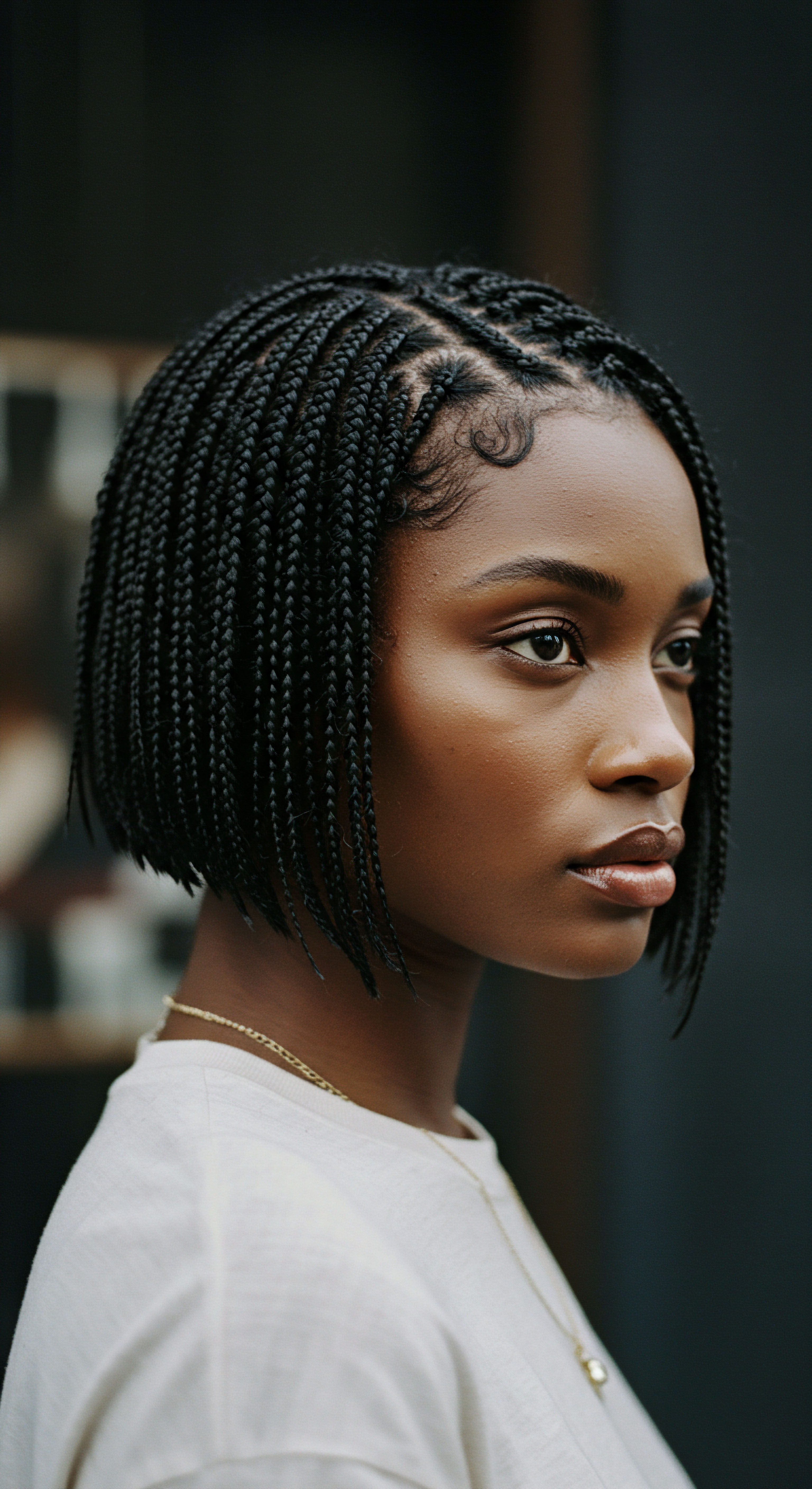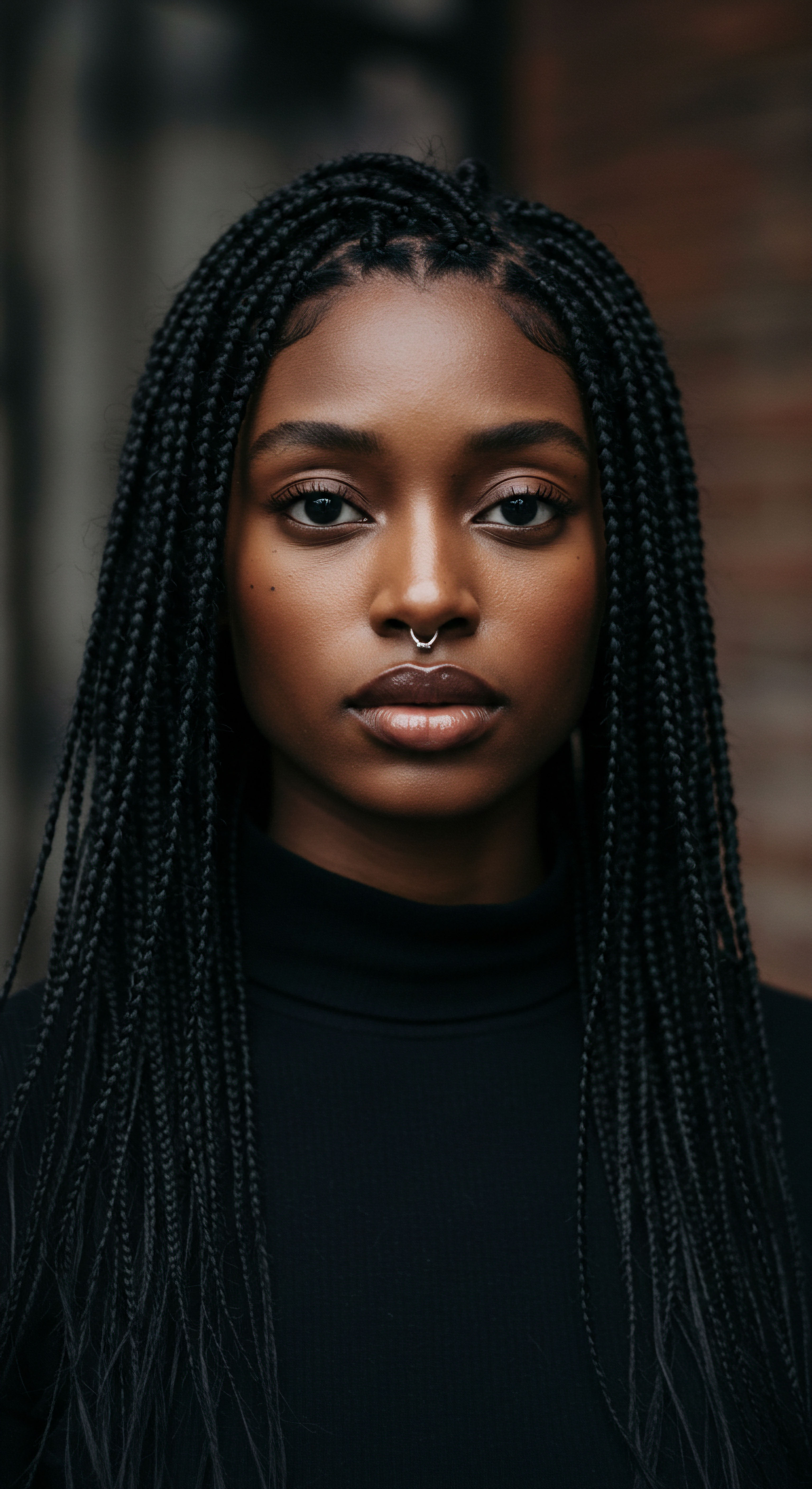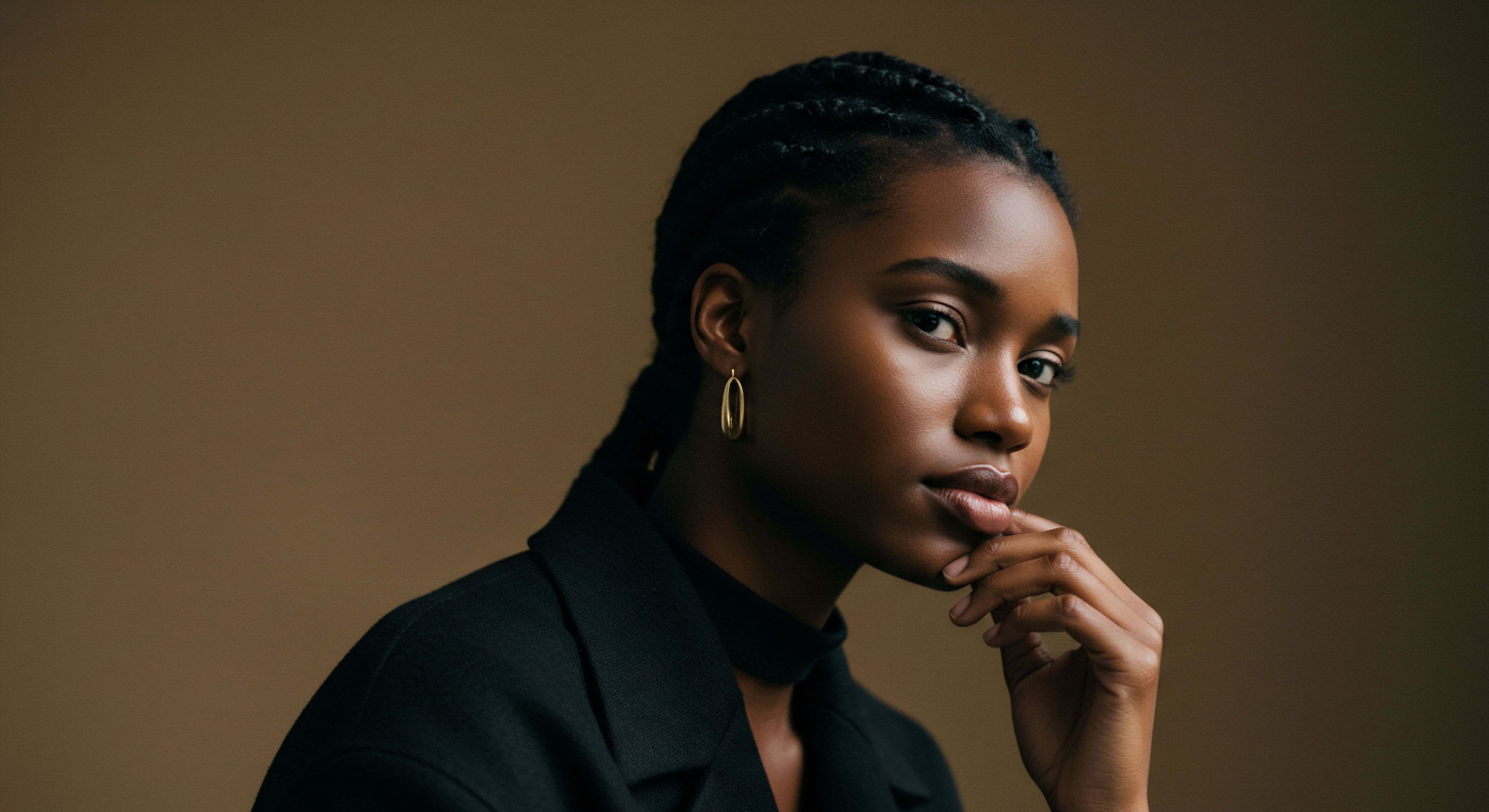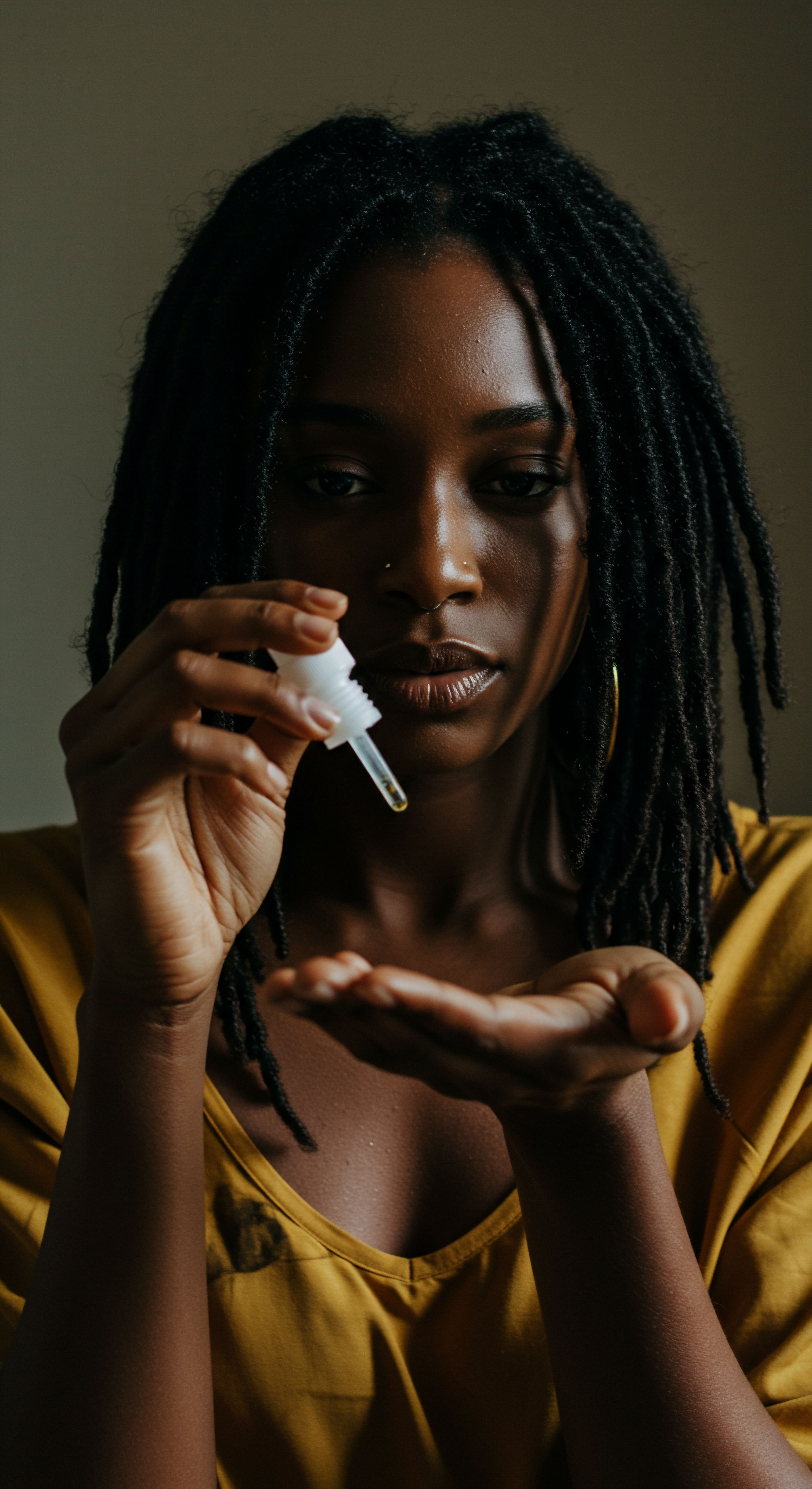
Roots
A gentle breeze carries whispers of ancient wisdom, a quiet knowing about the earth and its offerings, about self-preservation and beauty. For generations, the tending of textured hair has been a sacred act, a communion with lineage, and a declaration of identity. Within this rich tradition, protective styles stand as enduring symbols of ingenuity and artistry, offering respite and shelter for delicate strands.
Yet, a quiet paradox sometimes arises ❉ these very styles, designed to safeguard, can inadvertently become sources of distress if the scalp, the very ground from which our hair springs, is overlooked. To truly comprehend how consistent scalp care stands as a guardian against hair loss when protective styles are worn, we must first descend to the elemental, to the very beginnings of hair’s story, understanding its anatomy and the vibrant ecosystem residing upon our heads.
Our exploration begins beneath the surface, within the skin itself. Each strand of hair, a delicate filament, originates from a structure called the Hair Follicle. This tiny organ, nestled within the dermis, serves as the manufacturing hub for hair. For textured hair, these follicles possess a unique curvature, which dictates the distinctive coils, curls, and waves we celebrate.
This inherent curvature means that textured hair strands are not perfectly round but often elliptical or ribbon-like in cross-section. This structural particularity, while lending itself to incredible visual diversity, also presents specific vulnerabilities. The points where the hair bends most sharply within the follicle are areas of inherent weakness, rendering these strands more susceptible to mechanical stress and breakage if not handled with profound care.

Understanding Hair Follicle Dynamics
The life of a hair strand unfolds in distinct phases, a cycle of growth, rest, and release. This Hair Growth Cycle, comprising anagen (growth), catagen (transition), and telogen (resting/shedding), is a continuous, synchronized dance across the scalp. A healthy scalp environment supports this cycle, allowing follicles to perform their function optimally.
When this delicate balance is disturbed, whether by inflammation, excessive tension, or product buildup, the anagen phase can shorten, leading to premature shedding or thinner, weaker strands. The scalp, far from being a passive foundation, is a dynamic landscape, teeming with microscopic life and performing vital roles in hair sustenance.
The health of the scalp is the quiet architect of robust hair growth, particularly when strands are held within protective styles.
Consider the scalp’s outer layer, the stratum corneum, a protective barrier that shields underlying tissues from environmental aggressors and regulates moisture. Beneath this, sebaceous glands produce sebum, a natural oil that lubricates the hair and scalp, contributing to its barrier function. However, an overproduction or improper removal of sebum, especially when hair is in a protective style, can create an unwelcome environment for certain microorganisms.
A balanced scalp microbiome, a community of bacteria, fungi, and other microbes, is essential for maintaining scalp health. When this microbial community falls out of equilibrium, conditions like dandruff, seborrheic dermatitis, or even folliculitis can arise, each capable of impeding healthy hair growth and potentially leading to hair loss.

The Scalp Microbiome and Its Influence
Research increasingly illuminates the profound influence of the scalp microbiome on hair vitality. A 2021 review in Frontiers in Cellular and Infection Microbiology by Chen et al. discussed the complex interplay between scalp microbes and various conditions, noting that dysbiosis—an imbalance in this microbial community—can contribute to inflammation and discomfort, which in turn can compromise follicle function. This highlights that scalp care extends beyond mere cleanliness; it involves cultivating an environment where the beneficial microbes can thrive, thereby deterring those that cause irritation or damage.
- Follicle Health ❉ Proper scalp care keeps follicles clear of debris and inflammation, allowing for unobstructed hair growth.
- Sebum Balance ❉ Regular cleansing helps regulate sebum production, preventing excessive oiliness or dryness that can disrupt the scalp’s ecosystem.
- Microbiome Stability ❉ Thoughtful product choices and cleansing routines support a balanced community of microorganisms on the scalp.
When hair is in protective styles, direct access to the scalp is often limited. This makes the chosen care regimen even more significant. Neglecting the scalp during these periods can lead to accumulation of dead skin cells, product residue, and environmental pollutants.
This buildup can clog follicles, starve them of oxygen, and create an anaerobic environment where certain problematic bacteria or fungi can proliferate, potentially leading to irritation, itching, and ultimately, a compromised foundation for hair. Understanding these foundational elements of hair and scalp anatomy is the first step toward appreciating the critical role consistent, mindful scalp care plays in preserving hair density and vigor, even when strands are tucked away in their protective embrace.

Ritual
Stepping from the quiet wisdom of anatomical understanding, we arrive at the practical realm of daily practice, the rhythmic rituals that shape our hair’s wellbeing. The wearing of protective styles, a beautiful tradition, calls for a shift in our care routines, transforming them into acts of mindful attention rather than simple habit. How, then, do we transform this knowledge into tangible actions that shield our strands from the quiet threat of loss while they rest in their intricate designs? The answer lies in a consistent, gentle cadence of care, a ritual designed to nurture the scalp and fortify the hair, even when it is not fully exposed.
One of the primary concerns with protective styles is the temptation to neglect the scalp, assuming the hair is “safe” once braided or twisted. This oversight can be a silent precursor to distress. The scalp, still very much alive and active beneath the style, continues to produce sebum, shed skin cells, and collect environmental dust. Without regular, targeted cleansing, this accumulation can lead to a host of issues, from uncomfortable itching to inflammation that can weaken the hair follicle’s grip.

Cleansing the Hidden Scalp
The cornerstone of scalp care with protective styles is effective, yet gentle, cleansing. This often involves using a diluted shampoo or a dedicated scalp cleanser with a narrow applicator tip to reach between braids or twists. The goal is to purify the scalp without disturbing the style or introducing excessive moisture that could lead to mildew or prolonged drying times. Many prefer micellar water-based cleansers or astringent tonics applied with cotton swabs for lighter, more frequent touch-ups.
Gentle cleansing of the scalp beneath protective styles is not merely about freshness; it is a vital act of preservation.
The frequency of cleansing depends on individual scalp needs, activity levels, and the type of protective style. For some, a weekly targeted cleanse may suffice, while others might find a bi-weekly routine more suitable. The key is to listen to the scalp, observing for signs of irritation or buildup.
After cleansing, moisturizing the scalp is equally important. A dry scalp can become itchy, flaky, and prone to inflammation, all of which can contribute to hair breakage and discomfort. Light oils, serums, or leave-in conditioners formulated for scalp health can be applied directly to the scalp, massaged in gently to promote circulation and hydration.
Consider the texture of the products used. Heavy butters or thick oils, while seemingly beneficial, can sit on the scalp, clogging pores and attracting more debris. Opt for lighter, penetrating formulas that absorb readily without leaving a sticky residue.
| Care Step Targeted Cleansing |
| Purpose Removes buildup, prevents irritation |
| Recommended Product Type Diluted shampoo, micellar water, scalp cleanser with nozzle |
| Care Step Moisturizing |
| Purpose Hydrates scalp, reduces dryness and flaking |
| Recommended Product Type Lightweight oils, leave-in serums, scalp tonics |
| Care Step Gentle Stimulation |
| Purpose Promotes blood flow, distributes products |
| Recommended Product Type Fingertip massage, soft silicone scalp brush |
| Care Step Consistency and product suitability are paramount for effective scalp care. |

The Art of Product Application
Applying products with a light hand and specific tools can make a significant difference. Spritz bottles filled with diluted conditioning mist or a blend of water and light oils can help distribute moisture evenly across the length of the hair, especially the exposed ends, preventing dryness that can lead to brittleness and breakage. Remember, the ends of our hair are the oldest and most vulnerable sections, requiring particular tenderness.
Beyond cleansing and moisturizing, scalp massages, even gentle ones performed with fingertips, can stimulate blood flow to the follicles, delivering vital nutrients and promoting a sense of wellbeing. This simple act can also help distribute natural oils and applied products more evenly.
The journey of protective styling is not a set-it-and-forget-it endeavor. It is a continuous conversation with our hair and scalp, a series of thoughtful choices that uphold their health. By establishing and adhering to a consistent ritual of targeted cleansing, diligent moisturizing, and mindful application, we fortify the very roots of our hair, ensuring that our protective styles truly serve their purpose ❉ to shield, to grow, and to celebrate the vibrant life of textured hair.

Relay
As we move deeper into the layered understanding of scalp care and protective styles, a more profound sub-question arises ❉ What are the unseen tensions, both physical and systemic, that undermine hair vitality within these cherished styles? This inquiry moves beyond the surface-level application of products, beckoning us to consider the intricate interplay of biological resilience, cultural practices, and the sometimes-unacknowledged stressors that influence hair health. To truly safeguard our hair from loss, we must unravel these complexities, understanding that consistent scalp care acts as a critical buffer against these often-hidden forces.
The very definition of a protective style implies a reduction of daily manipulation and exposure. However, the initial installation of many protective styles, such as braids, twists, or weaves, often involves a degree of tension at the scalp. While a certain amount of tension is necessary for the style’s longevity, excessive or prolonged tension can lead to a condition known as Traction Alopecia. This form of hair loss results from repetitive or sustained pulling on the hair follicle, causing inflammation and, over time, permanent damage and scarring.

Understanding Tension and Follicle Response
The scalp’s response to tension is a complex biological cascade. When follicles are subjected to excessive pull, they enter a state of distress. This can manifest as tiny red bumps around the base of the braids, tenderness, or a persistent dull ache.
Over time, the body’s inflammatory response can lead to the destruction of the follicle itself, replacing it with scar tissue where hair can no longer grow. This is particularly relevant for textured hair, which, due to its unique structure, may be more vulnerable to breakage under tension compared to straight hair.
A significant study published in the Journal of the American Academy of Dermatology by Khumalo et al. (2017) highlighted the prevalence of traction alopecia among Black women, finding it to be the most common form of hair loss in this demographic, with a significant association with specific styling practices like tight braids and weaves. This data underscores the critical need for styles that prioritize scalp comfort and health over extreme tautness. Consistent scalp care, in this context, involves not only addressing inflammation once it occurs but also proactively choosing styles and installation methods that minimize tension from the outset.

The Unseen Stressors on Scalp Health
Beyond direct tension, other subtle stressors contribute to hair loss when protective styles are worn without adequate scalp attention. One such stressor is the accumulation of microscopic debris and microbial imbalances. When the scalp is not regularly cleansed and balanced, it becomes a breeding ground for opportunistic microorganisms.
For example, an overgrowth of certain yeasts, like Malassezia, commonly associated with seborrheic dermatitis, can lead to chronic itching, flaking, and inflammation. This persistent irritation can weaken the hair shaft and impair follicle function, ultimately contributing to shedding.
Furthermore, the restricted airflow to the scalp within dense protective styles can create a humid, warm environment. While beneficial for moisture retention for the hair strands, this environment can also foster the growth of certain bacteria or fungi if the scalp’s natural balance is disturbed by product buildup or infrequent cleansing. Consistent scalp care, therefore, serves as a vigilant steward, ensuring that this microclimate remains conducive to hair growth, not microbial proliferation.
- Tension Awareness ❉ Recognizing and avoiding styles that cause excessive pulling or discomfort at the roots.
- Microbial Balance ❉ Employing gentle, targeted cleansing to maintain a healthy scalp microbiome and deter overgrowth of problematic organisms.
- Product Selection ❉ Choosing lightweight, non-comedogenic products that do not clog pores or leave heavy residue on the scalp.
The cultural significance of protective styles cannot be overstated; they are expressions of heritage, artistry, and convenience. The solution to preventing hair loss does not lie in abandoning these styles, but rather in elevating the wisdom with which they are worn and cared for. This means a conscious choice for styles that allow for scalp access, a commitment to regular, gentle cleansing and moisturizing, and an unwavering attentiveness to the scalp’s signals.
It means prioritizing comfort and health over extreme aesthetics, recognizing that true beauty stems from a place of wellbeing. The relay of knowledge, from understanding the subtle biology of tension to appreciating the microbial ecosystem of the scalp, empowers us to wear our protective styles not just with beauty, but with profound care, ensuring that our hair continues to flourish for generations to come.

Reflection
As the quiet contemplation of hair’s journey settles, we are left with a deeper appreciation for the interconnectedness of all things. The hair on our heads, a living testament to our lineage and our vitality, thrives when its foundation, the scalp, is tended with consistent, knowing hands. Protective styles, far from being mere adornments, stand as opportunities for mindful stewardship, moments to truly listen to the subtle whispers of our scalp and respond with deliberate care.
This journey from the elemental root to the nuanced understanding of biological and cultural forces reminds us that true beauty springs from a place of deep respect, for ourselves, for our heritage, and for the delicate, powerful strands that crown us. The ongoing conversation with our hair is one of gentle nurturing, a timeless dance of understanding and preservation.

References
- Chen, Z. Zhang, J. Hu, J. Ni, X. & Li, S. (2021). The Scalp Microbiome in Health and Disease ❉ A Review. Frontiers in Cellular and Infection Microbiology, 11, 664929.
- Khumalo, N. P. Gumedze, F. & McMichael, A. J. (2017). The prevalence of traction alopecia in South African women. Journal of the American Academy of Dermatology, 77(6), 1146-1148.
- Aguh, C. & McMichael, A. (2018). Hair Loss in Women ❉ Medical and Cosmetic Approaches. Springer.
- Trueb, R. M. (2016). The impact of scalp conditions on hair growth and loss. Dermatology and Therapy, 6(3), 323-333.
- Sperling, L. C. & Cowper, S. E. (2006). The hair follicle ❉ an overview. Journal of Investigative Dermatology Symposium Proceedings, 11(1), 1-12.